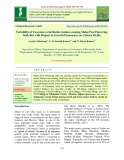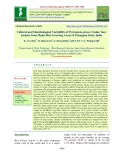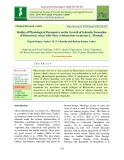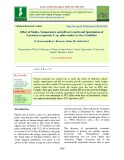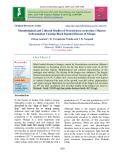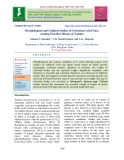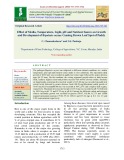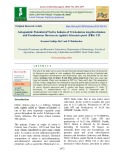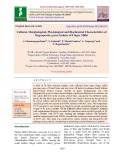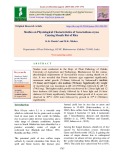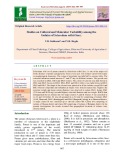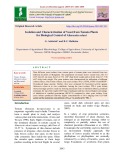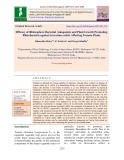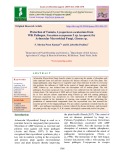
Mycelial dry weight
-
Maize Post flowering stalk rot causing caused by Fusarium verticillioides is major disease and causing yield loss up to 34 per cent. Different liquid media supporting the growth of the different isolates of fungus was observed. Among the eight-liquid media tested for the dry mycelial weight and sporulation of six isolates of Fusarium stalk rot pathogen (F. verticillioides), Isolate FV-3 yielded highest dry mycelial weight of 787.66mg, followed by FV-2 (647.66mg), FV1(581.00mg), FV-5 (451.00mg), FV-6(421.00mg) and FV7(277.66mg) in Takahashii’s broth.
 6p
6p  caygaocaolon7
caygaocaolon7
 18-09-2020
18-09-2020
 16
16
 0
0
 Download
Download
-
Rice blast caused by Pyricularia grisea (Cooke) Sacc. became one of the most important disease in rice growing areas of Telangana State because of its wide distribution and destructiveness under favourable conditions. However, sometimes resistant varieties may become ineffective due to evolutionary changes in the pathogen population. Keeping in view the importance of disease, studies were conducted on cultural and morphological variability of P. grisea isolates.
 9p
9p  kethamoi7
kethamoi7
 26-08-2020
26-08-2020
 24
24
 1
1
 Download
Download
-
Rhizoctonia root rot of okra caused by Rhizcotonia solani is an important disease which is known to cause heavy loss in Rajasthan as well as in India. Among physiological parameters effect of temperature, effect of pH and effect of relative humidity were study in vitro. The fungus grew at all the temperature level ranged from 15ºC to 35ºC. Maximum mycelial growth of the fungus (90mm) was observed at 30ºC. In different pH levels that maximum dry mycelium weight (630gm) of Rhizoctonia solani was observed at 6.5 pH level.
 8p
8p  caygaocaolon6
caygaocaolon6
 30-07-2020
30-07-2020
 7
7
 1
1
 Download
Download
-
Present research was carried out to study the effect of different culture media, temperature and pH on mycelia growth, sporulation, fresh weight and dry mycelial weight of Fusarium oxysporum f. sp. udum. Among seven culture media that were tested, the fungus grew the best on PDA and Czapek’s Dox agar media. The most suitable pH level for growth of fungus was 6.0 and 7.0 with excellent sporulation. Growth of Fusarium oxysporum f. sp. udum was maximum at 30˚C after seven days of inoculation, which was reduced drastically below 20˚C and above 30˚C.
 7p
7p  angicungduoc6
angicungduoc6
 22-07-2020
22-07-2020
 12
12
 2
2
 Download
Download
-
Black banded disease of mango, caused by Peziotrichum corticolum (Massee) Subramanian, is becoming severe for the last three to four years in all the mango growing regions. Morphological and cultural characteristics of the pathogen were studied. The identity of the fungus was confirmed. The fungus showed maximum radial growth on host extract dextrose agar on 12th day after incubation at 27±1oC. Culture of P. corticolum exhibited diversity with respect to cultural characters like type of the growth, mycelial colour, pigmentation and colony margin.
 11p
11p  trinhthamhodang6
trinhthamhodang6
 09-07-2020
09-07-2020
 11
11
 1
1
 Download
Download
-
Morphological and cultural variability of S. rolfsii infecting tomato were studied on different solid and liquid media based on radial growth, topography, sclerotial number, diameter of sclerotia, test weight of sclerotial bodies and dry mycelial weight. Significant variability with reference to mycelial and sclerotial characters was observed on different media. This investigation revealed that the maximum mycelial growth was observed in Potato Dextrose Agar (9 cm) and more test weight (262 mg) of sclerotial bodies was recorded in Sabouraud’s dextrose agar.
 8p
8p  chauchaungayxua6
chauchaungayxua6
 26-06-2020
26-06-2020
 7
7
 2
2
 Download
Download
-
The pathogen Bipolaris oryzae was subjected to different cultural conditions viz., media, temperature, pH, light and nutrient source under in vitro conditions. The maximum radial growth of 84.83 mm was recorded on paddy leaf extract agar followed by potato dextrose agar (61.33 mm). On this medium, the colony appeared greyish-white to dark brown, thick, leathery slightly raised and profuse mycelia with brown colored conidia.
 10p
10p  trinhthamhodang5
trinhthamhodang5
 16-05-2020
16-05-2020
 12
12
 0
0
 Download
Download
-
The aim of the study was to access the anti-bacterial and anti-fungal activity on the growth of Alternaria porri under in vitro condition. The antagonistic activity of bacterial and fungal antagonists (Pseudomonas and Trichoderma spp.) was determined by the dual culture technique both on King’s B and PDA media respectively, Paper disc assay and Agar well mathod. Plates were incubated at 28ºC for 7 days and 2 days. The antagonistic activity of these antagonists was evaluated by mycelial growth and mycelial dry weight of test fungus (Alternaria porri).
 6p
6p  chauchaungayxua5
chauchaungayxua5
 08-05-2020
08-05-2020
 16
16
 0
0
 Download
Download
-
A total of 24 blast infected samples were collected from major finger millet growing areas of Tamil Nadu and also from All India Coordinated Small Millets Improvement Project Centres (ICAR) in India. Pathogenicity test with Magnaporthe grisea isolates showed highly significant differences in virulence on the variety KM 252 in the severity of leaf blast. Among the five different media tested, the Oat Meal Agar medium (OMA) was found to be best for the growth of M. grisea isolates and all the isolates produced white colony colour. The mean mycelial growth was maximum in OMA medium with 80.
 16p
16p  cothumenhmong3
cothumenhmong3
 22-02-2020
22-02-2020
 35
35
 2
2
 Download
Download
-
Studies were conducted in the Dept. of Plant Pathology of Odisha University of Agriculture and Technology, Bhubaneswar for the various physiological requirements of Sarocladium oryzae causing sheath rot of rice. It was revealed that Potato dextrose agar supported significantly maximum radial growth (74.0mm) followed by Sabouraud’s medium (71.8mm) and Czapek’s dox medium (70.0mm). Significantly dry weight of mycelial mat was maximum at pH 4.0 (769.0mg) followed by pH 3.5 (746.6 mg). The highest radial growth was observed in 12 hour light and 12 hour darkness (68.
 8p
8p  cothumenhmong3
cothumenhmong3
 22-02-2020
22-02-2020
 11
11
 0
0
 Download
Download
-
Sclerotium wilt/ rot of potato caused by Sclerotium rolfsii Sacc. is one of the major soil borne diseases of potato causing heavy losses every year. Ten isolates varied with respect to morphological characters. The colour of mycelium was light buff to cottony white. The sclerotial initiation started between 5th and 9 th day in different isolates. The growth rate was excellent in DSr1, DSr2 and DSr3 isolates. The colour of sclerotia was dark brown in DSr1 and DSr3; brown in DSr2, DSr4, BSr1 and HSr1 while it was light brown in BSr3, HSr2 and HSr3.
 11p
11p  cothumenhmong3
cothumenhmong3
 22-02-2020
22-02-2020
 23
23
 0
0
 Download
Download
-
Nine different yeast isolates from various parts of tomato plant were isolated from two different locations of Bengaluru. The population on tomato leaves varied from 2.01-3.5 x104 cfu/cm², on stems from 6.4-7.31 x104 cfu/g fresh weight and on fruits from 6.7-7.38 x104 cfu/g fresh weight. The yeast isolates were characterized for utilization of different carbon sources. Out of nine isolates, four yeast isolates TPL-I, RTPL, RTPS- II and RTPFII produced lipase enzyme. Further, they were evaluated for biocontrol activity against Alternaria solani in in vitro conditions.
 8p
8p  trinhthamhodang3
trinhthamhodang3
 22-02-2020
22-02-2020
 15
15
 0
0
 Download
Download
-
Tomato is affected by a large number of diseases. Among these, collars rot disease of tomato cause by S. rolfsii is a threatening disease in eastern coastal regions of Odisha. Since, this disease is soil borne in nature, it is very difficult to control by chemical fungicides. The native rhizosphere soil of tomato was used for isolation and screening of bacterial antagonists for their efficacy and growth promotion potential. A total of 54 bacterial isolates were isolated from rhizosphere of tomato of which five isolates viz.
 12p
12p  trinhthamhodang3
trinhthamhodang3
 22-02-2020
22-02-2020
 26
26
 1
1
 Download
Download
-
Cultural and morphological characters of fifteen isolates of Sclerotium oryzae Catt. collected from different rice growing areas in Telangana and Andhra Pradesh states were studied. Significant differences in growth, mycelial dry weights and sclerotial characters were observed among the fifteen isolates grown on PDA and PDB. All the 15 isolates were divided into two groups based on the growth pattern on PDA. Group 1 consists of ten isolates SO2, SO3, SO5, SO6, SO7, SO10, SO11, SO12, SO14 and SO15 which exhibited fast growth rate in terms of colony diameter with a range of 80 mm to 83 mm.
 6p
6p  nguaconbaynhay3
nguaconbaynhay3
 07-02-2020
07-02-2020
 24
24
 0
0
 Download
Download
-
Arbuscular Mycorrhizal Fungi benefits plants by improving the uptake of phosphate and other nutrients from soil and also increases the disease tolerance to the host plant. The fungal pathogens cause huge loss to vegetable crops when infected. In order to overcome this problem, the influence of AMF in the control of fungal plant pathogens is studied. AMF, Glomus sp. was isolated from the rhizosphere soil of tomato plants. The wilt pathogen, Fusarium oxysporum f.sp. lycopersici was cultured from the infected roots of tomato plants.
 11p
11p  kethamoi2
kethamoi2
 15-12-2019
15-12-2019
 15
15
 0
0
 Download
Download
-
The accumulation of poly-β-hydroxybutyric acid (PHB) in 27 Streptomyces isolates with different taxonomical properties was investigated. The amount of synthesized PHB was determined as crotonic acid by spectrophotometry. Eighty percent of the tested isolates accumulated PHB between 0.3 and 7.6% of dry mycelial weight.
 4p
4p  vitamix
vitamix
 19-02-2019
19-02-2019
 17
17
 0
0
 Download
Download
CHỦ ĐỀ BẠN MUỐN TÌM









